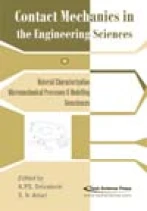Structural Durability & Health Monitoring Recognized as an ANVUR Scientific Journal
Tech Science Press Representative Featured in SSP Professional Profiles Series
International Journal of Mental Health Promotion Recognized as ANVUR Scientific Journal
Milestone for Oncologie: Now Indexed in DOAJ for Open Access Excellence

Edited by: A.P.S. Selvadurai and S. N. Atluri
The study of mechanics of contact has evolved as a legitimate field in the engineering sciences, where advanced mathematical concepts in modeling are combined with innovative solution schemes that involve both analytical and computational approaches.
The study of mechanics of contact has a rich history dating back to the observational approach of Leonardo da Vinci to the mechanics approach that commences with the work of C.A. Coulomb. Over the past two centuries the study of contact mechanics has evolved as a legitimate field in the engineering sciences, where advanced mathematical concepts in modelling are combined with innovative solution schemes that involve both analytical and computational approaches. The subject matter is also being applied to a variety of problem areas in the engineering sciences including, tribology, wear, mechanics of tactile sensors, biomechanics, geomechanics and earth sciences, material fragmentation, environmental sciences, micro-mechanics, materials engineering, smart sensors and the nano-sciences. This monograph contains three parts.
Part I: Micromechanical Processes and Modelling of Contact is devoted to topics of a fundamental nature arising in the areas of biomechanics, wear, fatigue, interface friction, indentation of elastic, poroelastic and rate sensitive materials with applications to parameter identification.
Part II: Contact Modelling in Material Characterization covers the important issues concerning the role of material parameter uncertainty in the modelling of contact between particles and the influence of stress-displacement relationships at rough contacts on the behaviour of particulate assemblies.
Part III: Contact Modelling in the Geosciences is devoted to research contributions that cover topics such as hydro-mechanical influences on failure of natural earth slopes, role of uncertainty on the mechanics of movement of large boulders, viscoplastic fragmentation of ice sheets during interaction with stationary structures and interaction of fragments with Coulomb contact, viscoplastic interactions between buried structures and rock masses and the influences of capillary mechanisms on the behaviour of granular media. Each topic has important applications to the understanding of complex interactions that are governed by influences of contact mechanics.
Hardcover. 320 pages. © 2010. ISBN-10: 0-9824205-2-8; ISBN-13:978-0-9824205-2-2.